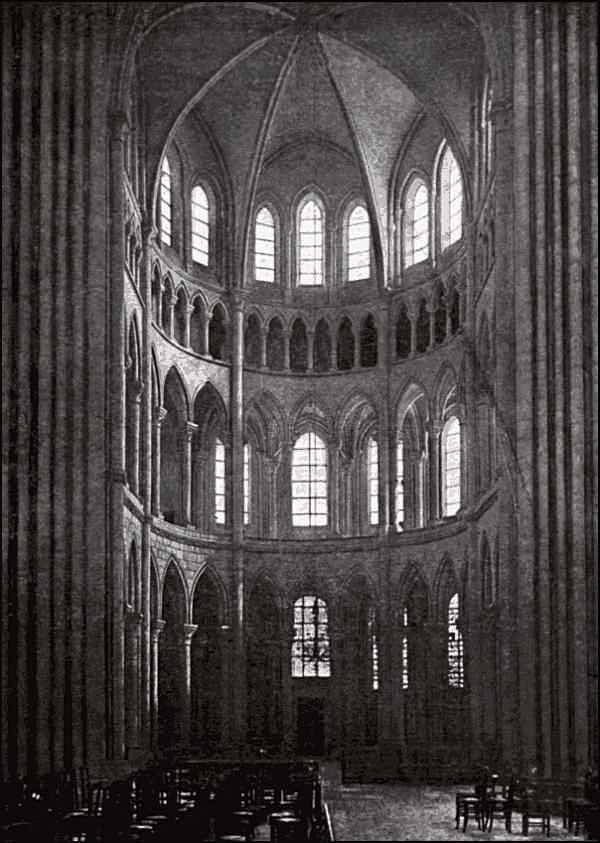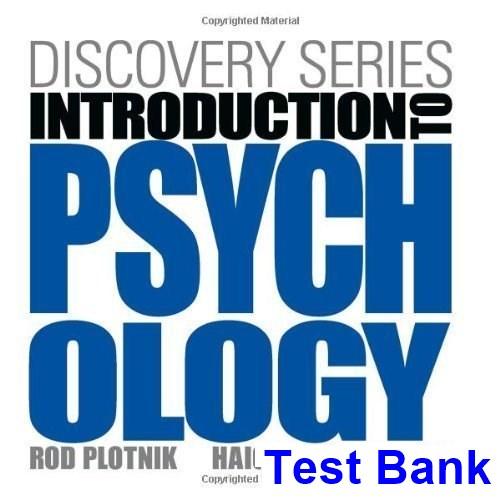
More products digital (pdf, epub, mobi) instant download maybe you interests ...
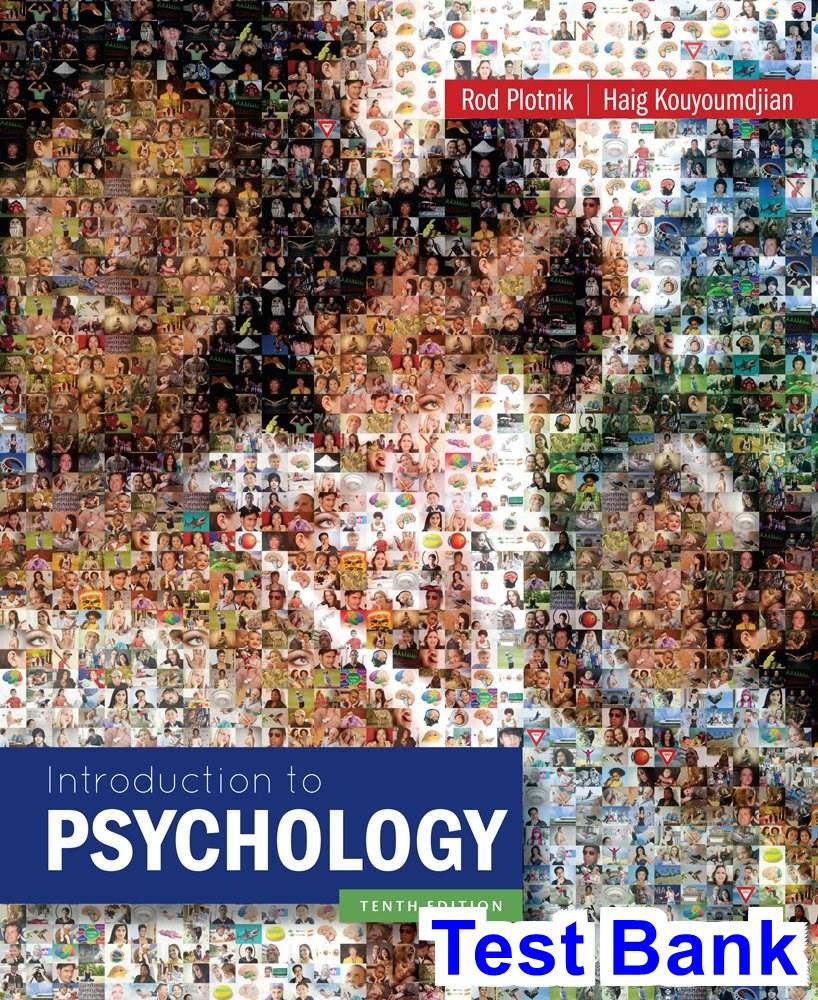
Introduction to Psychology 10th Edition Plotnik Test Bank
https://testbankfan.com/product/introduction-to-psychology-10thedition-plotnik-test-bank/
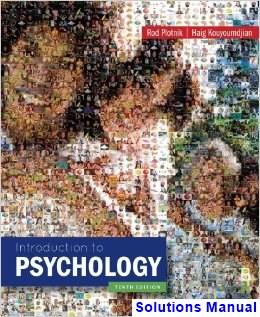
Introduction to Psychology 10th Edition Plotnik Solutions Manual
https://testbankfan.com/product/introduction-to-psychology-10thedition-plotnik-solutions-manual/
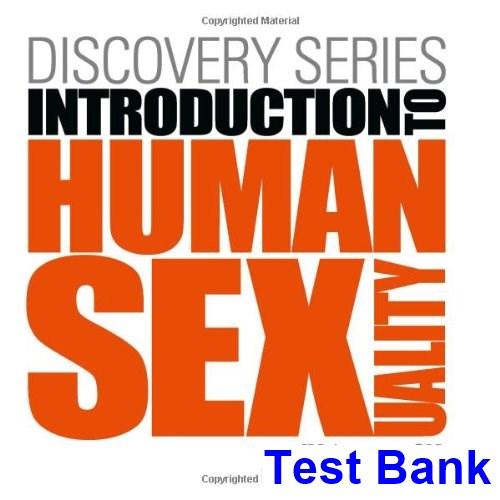
Discovery Series Human Sexuality 1st Edition Carroll Test Bank
https://testbankfan.com/product/discovery-series-humansexuality-1st-edition-carroll-test-bank/
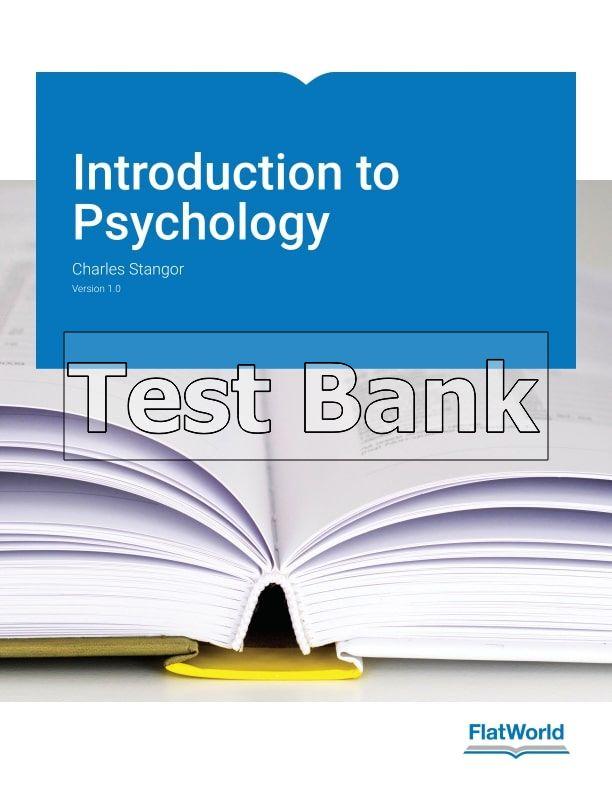
Introduction to Psychology Version 1.0 1st Edition Stangor Test Bank
https://testbankfan.com/product/introduction-to-psychologyversion-1-0-1st-edition-stangor-test-bank/
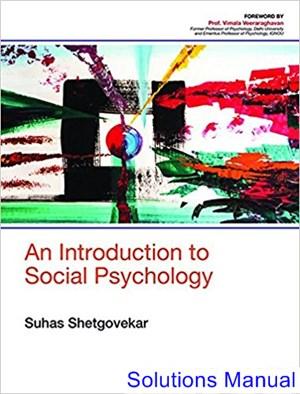
Introduction to Social Psychology 1st Edition Shetgovekar Solutions Manual
https://testbankfan.com/product/introduction-to-socialpsychology-1st-edition-shetgovekar-solutions-manual/
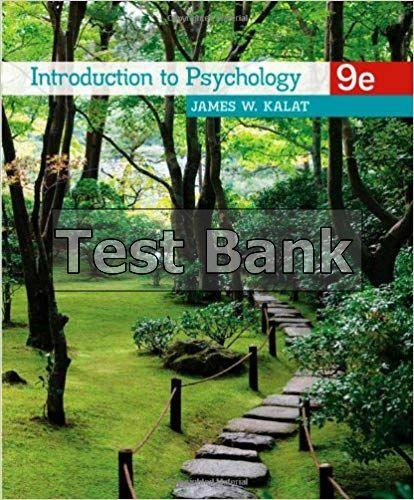
Introduction to Psychology 9th Edition Kalat Test Bank
https://testbankfan.com/product/introduction-to-psychology-9thedition-kalat-test-bank/
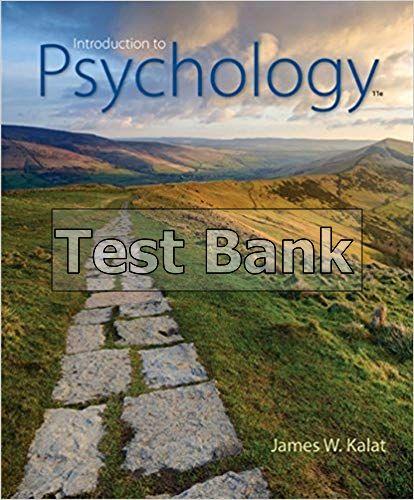
Introduction to Psychology 11th Edition Kalat Test Bank
https://testbankfan.com/product/introduction-to-psychology-11thedition-kalat-test-bank/
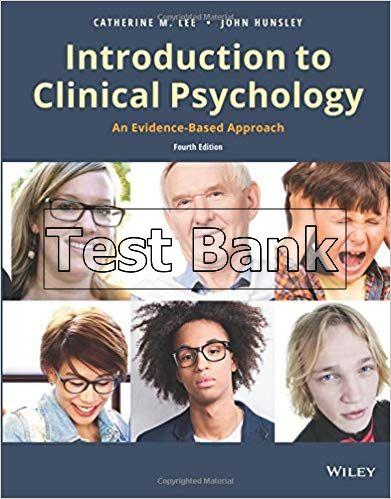
Introduction to Clinical Psychology 4th Edition Hunsley Test Bank
https://testbankfan.com/product/introduction-to-clinicalpsychology-4th-edition-hunsley-test-bank/
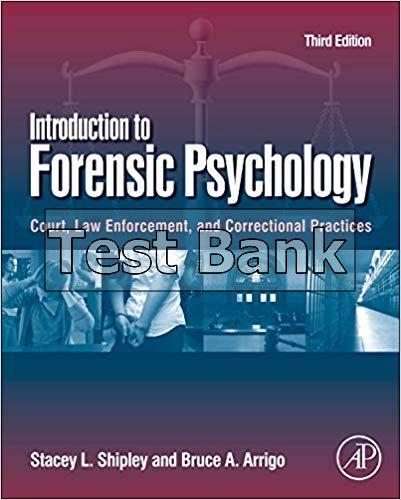
Introduction to Forensic Psychology 3rd Edition Shipley Test Bank
https://testbankfan.com/product/introduction-to-forensicpsychology-3rd-edition-shipley-test-bank/
MULTIPLE CHOICE
1. ____ focuses on the development of psychological tests.
a. Forensic psychology
b. School psychology
c. Personality psychology
d. Psychometrics
ANS: D PTS: 1 DIF: Bloom's: Remember REF: 7.1 Introduction, Textbook | Reading - Psychometrics, Online
OBJ: LO1 Describe psychometrics. MSC: TYPE: Easy
2. If your cousin told you she was in psychometrics, what would she be most likely doing in her career?
a. developing psychological tests measuring personality traits
b. studying the causes of schizophrenia
c. providing counseling to displaced factory workers
d. designing better instrumentation panels for aircrafts
ANS: A PTS: 1 DIF: Bloom's: Remember
REF: 7.1 Introduction, Textbook | Reading - Psychometrics, Online
OBJ: LO1 Describe psychometrics. MSC: TYPE: Easy
3. A psychologist employed by a company that develops and publishes intelligence and personality tests is most likely to have a degree in:
a. child development
b. basic research
c. psychometrics
d. clinical psychology
ANS: C PTS: 1 DIF: Bloom's: Understand REF: 7.1 Introduction, Textbook | Reading - Psychometrics, Online
OBJ: LO1 Describe psychometrics. MSC: TYPE: Easy
4. Which of the following is not a major question for psychologists as they measure intelligence?
a. how to define intelligence
b. how to explain intelligence test scores to the general public
c. how to construct a test to measure intelligence
d. how to explain intelligence
ANS: B PTS: 1
REF: 7.2 Defining Intelligence, Textbook
DIF: Bloom's: Understand
OBJ: LO2 Explain and distinguish between Spearman's two-factor theory, Gardner's multipleintelligence theory, Sternberg's triarchic theory, and Golemen's emotional intelligence theory.
MSC: TYPE: Easy
5. The ____ approach to intelligence is characterized by a focus on measuring the cognitive factors or abilities that make up intellectual performance.
a. psychometric
b. information processing
c. triarchic theory
d. Binet-Simon
ANS: A PTS: 1 DIF: Bloom's: Understand
REF: 7.2 Defining Intelligence, Textbook
OBJ: LO2 Explain and distinguish between Spearman's two-factor theory, Gardner's multipleintelligence theory, Sternberg's triarchic theory, and Golemen's emotional intelligence theory.
MSC: TYPE: Easy
6. What historical figure is most closely associated to the two-factor theory of intelligence?
a. Clarence Thomas
b. Charles Spearman
ANS: B PTS: 1
c. Alfred Binet
d. Lewis Terman
DIF: Bloom's: Remember
REF: 7.2 Defining Intelligence, Textbook | Reading - Two-Factor Theory, Online
OBJ: LO2 Explain and distinguish between Spearman's two-factor theory, Gardner's multipleintelligence theory, Sternberg's triarchic theory, and Golemen's emotional intelligence theory. MSC: TYPE: Easy
7. Charles Spearman’s two-factor theory says that intelligence is a:
a. combination of general factor (g) plus specific mental abilities (s)
b. group of separate and equally important mental abilities
c. set of processes for solving problems
d. combination of biological functions of the brain and nervous system
ANS: A PTS: 1
DIF: Bloom's: Remember
REF: 7.2 Defining Intelligence, Textbook | Reading - Two-Factor Theory, Online
OBJ: LO2 Explain and distinguish between Spearman's two-factor theory, Gardner's multipleintelligence theory, Sternberg's triarchic theory, and Golemen's emotional intelligence theory. MSC: TYPE: Easy
8. The most generally agreed upon aspects of intelligence are:
a. creativity, verbal ability, and memory
b. social competence, memory, and mathematical ability
c. problem-solving skills, motivation, and memory
d. general intelligence and specific factors
ANS: D PTS: 1
DIF: Bloom's: Understand
REF: 7.2 Defining Intelligence, Textbook | Reading - Two-Factor Theory, Online
OBJ: LO2 Explain and distinguish between Spearman's two-factor theory, Gardner's multipleintelligence theory, Sternberg's triarchic theory, and Golemen's emotional intelligence theory. MSC: TYPE: Easy
9. General intelligence, or g, correlates positively with:
a. math skills
b. athletic success
c. social skills
d. academic performance
ANS: D PTS: 1 DIF: Bloom's: Remember REF: 7.2 Defining Intelligence, Textbook | Reading - Two-Factor Theory, Online
OBJ: LO2 Explain and distinguish between Spearman's two-factor theory, Gardner's multipleintelligence theory, Sternberg's triarchic theory, and Golemen's emotional intelligence theory. MSC: TYPE: Medium
10. Charles Spearman developed the ____ theory, which termed the general intelligence factor as “g” and specific factors as “s.”
a. multiple-factor
b. triarchic
c. information processing
d. two-factor
ANS: D PTS: 1 DIF: Bloom's: Remember REF: 7.2 Defining Intelligence, Textbook | Reading - Two-Factor Theory, Online
OBJ: LO2 Explain and distinguish between Spearman's two-factor theory, Gardner's multipleintelligence theory, Sternberg's triarchic theory, and Golemen's emotional intelligence theory. MSC: TYPE: Easy
11. The two-factor theory divides intelligence into:
a. verbal skills and math skills
b. spatial abilities and movement abilities
c. general intelligence and specific abilities
d. insight about the self and insight about others
ANS: C PTS: 1
DIF: Bloom's: Remember
REF: 7.2 Defining Intelligence, Textbook | Reading - Two-Factor Theory, Online
OBJ: LO2 Explain and distinguish between Spearman's two-factor theory, Gardner's multipleintelligence theory, Sternberg's triarchic theory, and Golemen's emotional intelligence theory. MSC: TYPE: Easy
12. Which of the following is a disadvantage to the two-factor theory of intelligence?
a. The single intelligence score is not predictive of anything.
b. It does not take into account other kinds of intelligence.
c. People get credit for being intelligent in several different domains.
d. The intelligence quotient (IQ score) is based on a general intelligence factor.
ANS: B PTS: 1
DIF: Bloom's: Understand
REF: 7.2 Defining Intelligence, Textbook | Reading - Two-Factor Theory, Online
OBJ: LO2 Explain and distinguish between Spearman's two-factor theory, Gardner's multipleintelligence theory, Sternberg's triarchic theory, and Golemen's emotional intelligence theory. MSC: TYPE: Medium
13. Howard Gardner defines intelligence as composed of:
a. an overall mental ability
b. a few dependent mental abilities
c. many separate mental abilities
d. analytical and logical thinking
ANS: C PTS: 1 DIF: Bloom's: Understand
REF: 7.2 Defining Intelligence, Textbook | Reading - Multiple Intelligence Theory, Online
OBJ: LO2 Explain and distinguish between Spearman's two-factor theory, Gardner's multipleintelligence theory, Sternberg's triarchic theory, and Golemen's emotional intelligence theory. MSC: TYPE: Easy
14. Spearman is to Gardner as ____ is to ____.
a. multiple; single
c. triarchic; multiple b. single; multiple d. multiple; triarchic
ANS: B PTS: 1 DIF: Bloom's: Understand REF: 7.2 Defining Intelligence, Textbook | Reading - Multiple Intelligence Theory, Online
OBJ: LO2 Explain and distinguish between Spearman's two-factor theory, Gardner's multipleintelligence theory, Sternberg's triarchic theory, and Golemen's emotional intelligence theory. MSC: TYPE: Medium
15. For Sternberg, intelligence is measured by:
a. analyzing the steps that people take in solving problems
b. asking people to define various types of words
c. how well they do in academic settings
d. the activation of neural assemblies in the cerebral cortex
ANS: A PTS: 1
DIF: Bloom's: Remember
REF: 7.2 Defining Intelligence, Textbook | Reading - Multiple Intelligence Theory, Online
OBJ: LO2 Explain and distinguish between Spearman's two-factor theory, Gardner's multipleintelligence theory, Sternberg's triarchic theory, and Golemen's emotional intelligence theory. MSC: TYPE: Medium
16. Robert Sternberg’s triarchic theory focuses on the three:
a. types of IQ testing procedures
b. ways of gathering and processing information
c. forms of emotional expression
d. parts of the brain used for memory
ANS: B PTS: 1
DIF: Bloom's: Understand
REF: 7.2 Defining Intelligence, Textbook | Reading - Triarchic Theory, Online
OBJ: LO2 Explain and distinguish between Spearman's two-factor theory, Gardner's multipleintelligence theory, Sternberg's triarchic theory, and Golemen's emotional intelligence theory. MSC: TYPE: Easy
17. The triarchic theory focuses on the three aspects of intelligence. Which of the following is not among the three as presented in the textbook?
a. analytical
b. problem solving
ANS: C PTS: 1
c. affective
d. practical
DIF: Bloom's: Understand
REF: 7.2 Defining Intelligence, Textbook | Reading - Triarchic Theory, Online
OBJ: LO2 Explain and distinguish between Spearman's two-factor theory, Gardner's multipleintelligence theory, Sternberg's triarchic theory, and Golemen's emotional intelligence theory. MSC: TYPE: Easy
18. The triarchic theory approach to intelligence emphasizes the:
a. machine-like efficiency with which our computer minds crunch numbers and sort data
b. cognitive processes people use to solve problems
c. biological changes in the brain and nervous system that result from information input
d. single core ability on which all related intellectual skills are based
ANS: B PTS: 1
DIF: Bloom's: Understand
REF: 7.2 Defining Intelligence, Textbook | Reading - Triarchic Theory, Online
OBJ: LO2 Explain and distinguish between Spearman's two-factor theory, Gardner's multipleintelligence theory, Sternberg's triarchic theory, and Golemen's emotional intelligence theory. MSC: TYPE: Medium
19. You take part in a study in which you are asked to talk out loud as you solve a series of difficult problems. The researcher takes notes on your strategies in order to study the mental processes you use to solve various problems. This researcher is using the ____ approach to the study of intelligence.
a. behavioral
b. humanistic
c. psychometric
d. triarchic
ANS: D PTS: 1 DIF: Bloom's: Analyze
REF: 7.2 Defining Intelligence, Textbook | Reading - Triarchic Theory, Online
OBJ: LO2 Explain and distinguish between Spearman's two-factor theory, Gardner's multipleintelligence theory, Sternberg's triarchic theory, and Golemen's emotional intelligence theory. MSC: TYPE: Medium
20. Robert Sternberg’s triarchic theory has the advantage of:
a. giving credit to people for abilities that are not normally measured by standard tests of intelligence
b. explaining differences in intelligence between people
c. stressing affective factors
d. identifying parts of the brain that are involved in critical thinking
ANS: A PTS: 1
DIF: Bloom's: Understand
REF: 7.2 Defining Intelligence, Textbook | Reading - Triarchic Theory, Online
OBJ: LO2 Explain and distinguish between Spearman's two-factor theory, Gardner's multipleintelligence theory, Sternberg's triarchic theory, and Golemen's emotional intelligence theory. MSC: TYPE: Medium
21. Which of the following is a disadvantage to the triarchic approach?
a. It does not give people credit for being intelligent in multiple ways.
b. It ignores the influence that problem-solving skills have on overall intelligence.
c. Only a few tests are available to measure the various ways that people think.
d. There is no consideration of analytical thinking.
ANS: C PTS: 1
DIF: Bloom's: Understand
REF: 7.2 Defining Intelligence, Textbook | Reading - Triarchic Theory, Online
OBJ: LO2 Explain and distinguish between Spearman's two-factor theory, Gardner's multipleintelligence theory, Sternberg's triarchic theory, and Golemen's emotional intelligence theory. MSC: TYPE: Medium
22. What is the ability to perceive emotions accurately, to take feelings into account when reasoning, to understand emotions, and to regulate or manage emotions in oneself and others?
a. psychometric
b. emotional intelligence
ANS: D PTS: 1
c. general factor
d. information processing
DIF: Bloom's: Understand
REF: 7.2 Defining Intelligence, Textbook | Video - Emotional Intelligence, Online
OBJ: LO2 Explain and distinguish between Spearman's two-factor theory, Gardner's multipleintelligence theory, Sternberg's triarchic theory, and Golemen's emotional intelligence theory. MSC: TYPE: Medium
23. Why has the concept of “g” remained so popular among psychologists?
a. “g” takes into account musical, athletic, and creative forms of intelligence.
b. The research clearly shows the idea of multiple intelligences is not valid.
c. Most of the research on intelligence is based on the psychometric approach.
d. The multiple-intelligence theory is widely accepted.
ANS: C PTS: 1
REF: 7.2 Defining Intelligence, Textbook
DIF: Bloom's: Understand
OBJ: LO2 Explain and distinguish between Spearman's two-factor theory, Gardner's multipleintelligence theory, Sternberg's triarchic theory, and Golemen's emotional intelligence theory. MSC: TYPE: Medium
24. Based upon observations, Galton concluded that intelligence could be measured by assessing:
a. head size
b. reaction to a puzzle box
ANS: A PTS: 1
REF: 7.3 Measuring Intelligence, Textbook
c. responses to inkblots
d. reading comprehension
DIF: Bloom's: Remember
OBJ: LO3 Summarize the historical background of measuring intelligence.
MSC: TYPE: Easy
25. Francis Galton attempted to determine the relationship between ____ and ____.
a. brain size; IQ
b. reaction to a puzzle box; IQ
c. responses to inkblots; head size
d. head size; students’ grade point averages
ANS: D PTS: 1
DIF: Bloom's: Remember REF: 7.3 Measuring Intelligence, Textbook
OBJ: LO3 Summarize the historical background of measuring intelligence.
MSC: TYPE: Easy
26. Binet believed that intelligence was ____ and that it could be measured by ____.
a. a general ability; putting the individual into novel situations
b. a collection of mental abilities; assessing a person’s ability to perform cognitive tasks
c. a collection of mental abilities; reaction time
d. genetic; assessing a person’s skull size
ANS: B PTS: 1
REF: 7.3 Measuring Intelligence, Textbook
DIF: Bloom's: Understand
OBJ: LO3 Summarize the historical background of measuring intelligence.
MSC: TYPE: Medium
27. ____ gives an indication of a child’s intelligence by comparing her score on an intelligence test to the scores of average children her same age.
a. Intellectual age
b. Cognitive age
c. Mental age
d. Formula age
ANS: C PTS: 1 DIF: Bloom's: Remember
REF: 7.3 Measuring Intelligence, Textbook
OBJ: LO3 Summarize the historical background of measuring intelligence.
MSC: TYPE: Easy
28. Bethany has a mental age of 5. This means that she must:
a. be 5 years of age
b. have answered intelligence test items that could be answered by an average 5-year-old
c. have answered at least half of the intelligence items considered appropriate for the average 6-year-old
d. have an intelligence level that matches her chronological age
ANS: B PTS: 1
DIF: Bloom's: Apply REF: 7.3 Measuring Intelligence, Textbook
OBJ: LO3 Summarize the historical background of measuring intelligence. MSC: TYPE: Medium
29. The average fourteen-year-old will have a ratio IQ score of:
a. 80
b. 100
ANS: B PTS: 1
c. 120
d. impossible to calculate
DIF: Bloom's: Understand REF: 7.3 Measuring Intelligence, Textbook
OBJ: LO4 Describe the IQ formula. MSC: TYPE: Easy
30. If you were to take a contemporary intelligence test, your IQ score would actually be called:
a. interval IQ
b. nominal IQ
ANS: D PTS: 1
c. ratio IQ
d. deviation IQ
DIF: Bloom's: Remember REF: 7.3 Measuring Intelligence, Textbook
OBJ: LO4 Describe the IQ formula. MSC: TYPE: Easy
31. Professor Lundberg starts his lecture with, “Today, we are going to examine psychometrics.” Which of the following props is Professor Lundberg most likely to have brought to class with him today?
a. William James’ early writings
b. a video on Sigmund Freud
ANS: D PTS: 1
c. a model of the brain
d. the Wechsler Adult Intelligence Scale
DIF: Bloom's: Apply REF: 7.3 Measuring Intelligence, Textbook
OBJ: LO5 Describe the Wechsler Intelligence Scales. MSC: TYPE: Easy
32. Of the following, which test is the most widely used IQ test today?
a. Multiple Intelligence Test
b. Binet-Simon Intelligence Test
ANS: C PTS: 1
c. Wechsler Adult Intelligence Scale
d. Stanford-Binet test
DIF: Bloom's: Remember REF: 7.3 Measuring Intelligence, Textbook
OBJ: LO5 Describe the Wechsler Intelligence Scales. MSC: TYPE: Easy
33. The current version of the Wechsler Adult Intelligence Scale consists of items that assess:
a. verbal and performance skills
b. general intelligence and specific abilities
c. analytical and logical thinking skills
d. practical thinking and problem-solving abilities
ANS: A PTS: 1
DIF: Bloom's: Remember REF: 7.3 Measuring Intelligence, Textbook
OBJ: LO5 Describe the Wechsler Intelligence Scales. MSC: TYPE: Easy
34. You have recently had your handwriting analyzed to measure your intelligence. Much to your surprise, handwriting analysis is usually:
a. as good as the Wechsler intelligence scales
b. no better than a good guess
c. as good as the Simon-Binet scale
d. a reliable and valid measure of intelligence
ANS: B PTS: 1
REF: 7.3 Measuring Intelligence, Textbook
DIF: Bloom's: Understand
OBJ: LO6 Discuss the role of validity and reliability in intelligence tests.
MSC: TYPE: Easy
35. If a test measures what it is supposed to be measuring, then we can say that the test is:
a. reliable
b. consistent
ANS: C PTS: 1
REF: 7.3 Measuring Intelligence, Textbook
c. valid
d. organic
DIF: Bloom's: Remember
OBJ: LO6 Discuss the role of validity and reliability in intelligence tests.
MSC: TYPE: Easy
36. This question measures your understanding of an important concept in an intelligence test because it is designed to. This refers to the question’s:
a. validity
b. reliability
ANS: A PTS: 1
REF: 7.3 Measuring Intelligence, Textbook
c. practical nature
d. clarity
DIF: Bloom's: Understand
OBJ: LO6 Discuss the role of validity and reliability in intelligence tests.
MSC: TYPE: Easy
37. How could a test’s validity be checked?
a. Let subjects take the test several times within one month.
b. Correlate subjects’ scores with their scores from a test with proven validity.
c. Some subjects take the first half of the test and others take the second half and then the scores are compared.
d. Develop two versions of the same test and examine the correlation between the two scores.
ANS: B PTS: 1
REF: 7.3 Measuring Intelligence, Textbook
DIF: Bloom's: Understand
OBJ: LO6 Discuss the role of validity and reliability in intelligence tests.
MSC: TYPE: Difficult
38. A test is said to be reliable if it:
a. measures what it is supposed to measure
b. gives consistent results for any given person
c. tests many different abilities
d. does not show racial and ethnic differences in scores
ANS: B PTS: 1 DIF: Bloom's: Remember
REF: 7.3 Measuring Intelligence, Textbook
OBJ: LO6 Discuss the role of validity and reliability in intelligence tests.
MSC: TYPE: Easy
39. “Each time I enter this command on my computer, it does different things.” This person ought to toss this computer because it has low:
a. heritability
b. validity
ANS: C PTS: 1
c. reliability
d. distribution
DIF: Bloom's: Understand REF: 7.3 Measuring Intelligence, Textbook
OBJ: LO6 Discuss the role of validity and reliability in intelligence tests.
MSC: TYPE: Easy
40. A psychologist tries out a new intelligence test on a child. One month later, she administers the same test to the same child and finds little correlation between the two administrations of the test. In testing terminology, it would be said that the test is:
a. context-dependent
b. sensitive
ANS: C PTS: 1
c. unreliable
d. invalid
DIF: Bloom's: Understand REF: 7.3 Measuring Intelligence, Textbook
OBJ: LO6 Discuss the role of validity and reliability in intelligence tests.
MSC: TYPE: Medium
41. A normal distribution is one in which:
a. the majority of scores are high
b. the majority of scores are low
ANS: C PTS: 1
c. the majority of scores fall in the middle
d. all scores fall in the middle range
DIF: Bloom's: Remember REF: 7.3 Measuring Intelligence, Textbook
OBJ: LO7 Discuss the distribution and use of IQ scores. MSC: TYPE: Easy
42. If you were to describe a normal distribution as a shape, you would say that it resembles:
a. a bell
b. two evenly elevated hills
ANS: A PTS: 1
REF: 7.3 Measuring Intelligence, Textbook
c. a landslide
d. a line slowly moving upward
DIF: Bloom's: Remember
OBJ: LO7 Discuss the distribution and use of IQ scores. MSC: TYPE: Easy
43. The average IQ score in a normal distribution is:
a. 85
b. 100
ANS: B PTS: 1
c. 115
d. 120
DIF: Bloom's: Remember REF: 7.3 Measuring Intelligence, Textbook
OBJ: LO7 Discuss the distribution and use of IQ scores. MSC: TYPE: Easy
44. Alan has a mild intellectual disability. What can we expect with regard to Alan’s functioning in the future?
a. Alan will become partially independent, but must still rely upon others for support
b. Alan will learn to read and write and become self-supporting
c. Alan will need custodial care in some kind of institution
d. He will require intensive supervision
ANS: B PTS: 1
REF: 7.3 Measuring Intelligence, Textbook
DIF: Bloom's: Understand
OBJ: LO7 Discuss the distribution and use of IQ scores. MSC: TYPE: Easy
45. Persons with profound intellectual disabilities have IQs in which of the following ranges?
a. 75 to 105
b. 50 to 75
ANS: D PTS: 1
c. 35 to 50
d. 20 to 40
DIF: Bloom's: Remember REF: 7.3 Measuring Intelligence, Textbook
OBJ: LO7 Discuss the distribution and use of IQ scores. MSC: TYPE: Easy
46. A moderately gifted child has an IQ between:
a. 100-115
b. 120-135
ANS: C PTS: 1
c. 130-150
d. 180-200
DIF: Bloom's: Remember REF: 7.3 Measuring Intelligence, Textbook
OBJ: LO7 Discuss the distribution and use of IQ scores. MSC: TYPE: Easy
47. Which of the following individuals would be classified as “gifted”?
a. Larry, with an IQ score of 100
b. Tanner, with an IQ score of 110
ANS: D PTS: 1
c. Delaney, with an IQ score of 65
d. Katie, with an IQ of 145
DIF: Bloom's: Remember REF: 7.3 Measuring Intelligence, Textbook
OBJ: LO7 Discuss the distribution and use of IQ scores. MSC: TYPE: Medium
48. Which of the following summarizes the debate on the contributions of genetics and environment on intelligence?
a. heredity-neutral
b. neutral-nurture
ANS: C PTS: 1
c. nature-nurture
d. nature-neutral
DIF: Bloom's: Remember
REF: 7.4 Influences on Intelligence, Textbook
OBJ: LO8 Discuss the role of nature and nurture in intelligence.
MSC: TYPE: Easy
49. In the matter of intelligence, the answer to the nature-nurture question is that:
a. twin studies prove the predominance of nurture
b. adoption studies prove the predominance of nature
c. intervention programs show that intelligence is fixed at birth
d. both nature and nurture contribute to the formation of intelligence
ANS: D PTS: 1
DIF: Bloom's: Understand REF: 7.4 Influences on Intelligence, Textbook
OBJ: LO8 Discuss the role of nature and nurture in intelligence.
MSC: TYPE: Medium
50. The nature-nurture question contemplates the contribution of ____ and ____ to the development of intelligence.
a. cultural factors; family environment
c. skull size; brain size
b. genetic factors; environmental factors d. wealth; education
ANS: B PTS: 1
DIF: Bloom's: Understand
REF: 7.4 Influences on Intelligence, Textbook
OBJ: LO8 Discuss the role of nature and nurture in intelligence.
MSC: TYPE: Easy
51. Which family relationship has the most genes in common?
a. identical twins reared together
b. fraternal twins reared together
ANS: A PTS: 1
c. siblings raised apart
d. fraternal twins reared apart
DIF: Bloom's: Remember
REF: 7.4 Influences on Intelligence, Textbook
OBJ: LO8 Discuss the role of nature and nurture in intelligence.
MSC: TYPE: Easy
52. An “environmental factor” explanation for the racial differences in IQ scores would focus on:
a. hormonal differences
b. genetic differences
ANS: C PTS: 1
c. poverty’s impact
d. biological factors
DIF: Bloom's: Understand
REF: 7.4 Influences on Intelligence, Textbook | Reading - Intervention Programs, Online | ReadingRacial Controversy, Online
OBJ: LO8 Discuss the role of nature and nurture in intelligence.
MSC: TYPE: Medium
53. The term ____ refers to mental processes that we use to be creative, to form concepts, and to problem solve.
a. information processing
b. thinking
ANS: B PTS: 1
c. cognitive
d. behavioral
DIF: Bloom's: Understand REF: 7.5 Forming Concepts, Textbook OBJ: LO9 Define thinking and concept.
MSC: TYPE: Easy
54. The areas of thinking and language are important topics to study in the ____ approach.
a. cognitive
b. psychoanalytic
ANS: A PTS: 1
c. humanistic
d. behavioral
DIF: Bloom's: Remember REF: 7.5 Forming Concepts, Textbook OBJ: LO9 Define thinking and concept.
MSC: TYPE: Easy
55. When we use rules to form and manipulate symbols in order to communicate, we are using:
a. analogies
b. prototypes
ANS: C PTS: 1
c. language
d. concepts
DIF: Bloom's: Understand REF: 7.5 Forming Concepts, Textbook OBJ: LO9 Define thinking and concept.
MSC: TYPE: Medium
56. A “concept” can best be defined as a(n):
a. object that fits a series of prescribed rules
b. idea regarding the solution to a problem
c. novel use for an object or tool
d. way to group items based upon common characteristics
ANS: D PTS: 1
DIF: Bloom's: Understand REF: 7.5 Forming Concepts, Textbook | Animation - Concept Formation, Online OBJ: LO9 Define thinking and concept. MSC: TYPE: Easy
57. Concepts are crucial to effective thinking because without concepts, we would:
a. not know the rules for logical thought
b. forget most of what we learn
c. be overwhelmed by apparently unrelated pieces of information
d. lose our motivation to think
ANS: C PTS: 1
DIF: Bloom's: Understand
REF: 7.5 Forming Concepts, Textbook | Animation - Concept Formation, Online OBJ: LO9 Define thinking and concept. MSC: TYPE: Medium
58. When you are asked to indicate what Sigmund Freud, Albert Bandura, Abraham Maslow, and Lewis Terman all have in common, you’re really being asked to form a(n):
a. concept
b. object rule
ANS: A PTS: 1
c. hierarchy
d. analogy
DIF: Bloom's: Apply
REF: 7.5 Forming Concepts, Textbook OBJ: LO9 Define thinking and concept.
MSC: TYPE: Medium
59. You overhear Brent talking with David. But the only thing you hear is David saying, “They all have wings.” You ask Brent for a clarification and he says, “A bird, a plane, and a butterfly.” Then you realize that they’re:
a. talking about transformational rules
b. grouping objects using some common property they all share
c. referring to telegraphic speech
d. overgeneralizing
ANS: B PTS: 1
DIF: Bloom's: Analyze REF: 7.5 Forming Concepts, Textbook OBJ: LO9 Define thinking and concept.
MSC: TYPE: Medium
60. You are playing a guessing game with a child and you want the child to guess “cat.” You give clues that the animal has four legs, fur, and whiskers, but the child guesses wrong each time. Then you give the hint that the animal purrs and the child correctly guesses “cat.” In terms of concept formation, you supplied the child with a(n):
a. leading clue
b. essential characteristic
ANS: B PTS: 1
c. exemplar
d. prototype
DIF: Bloom's: Apply
REF: 7.5 Forming Concepts, Textbook OBJ: LO9 Define thinking and concept.
MSC: TYPE: Medium
61. Which of the following is a problem of the exemplar theory of forming concepts?
a. It allows us to better store information in memory.
b. It allows us to identify things without relearning.
c. Exceptions never occur.
d. Listing all the defining properties of a concept is very difficult.
ANS: D PTS: 1
REF: 7.5 Forming Concepts, Textbook
DIF: Bloom's: Understand
OBJ: LO10 Describe how the exemplar model and prototype theory explain how concepts are formed. MSC: TYPE: Medium
62. An average bird has feathers, bill, and wings. This is consistent with the:
a. set theory
b. heuristic theory
ANS: D PTS: 1
c. exemplar theory
d. prototype theory
DIF: Bloom's: Understand REF: 7.5 Forming Concepts, Textbook OBJ: LO11 Describe the functions of concepts.
MSC: TYPE: Easy
63. Bill likes to invent. Today he is inventing a new car. He says to himself, “I can visualize what this new car should look like. An average car has an engine, wheels, and so on.” His approach to inventing uses the ____ theory of forming concepts.
a. surface
b. heuristic
ANS: C PTS: 1
c. prototype
d. set
DIF: Bloom's: Apply
REF: 7.5 Forming Concepts, Textbook OBJ: LO11 Describe the functions of concepts.
MSC: TYPE: Easy
64. Which of the following is a characteristic of prototype theory?
a. not including exceptions in the list of defining properties
b. listing all of the essential features of an object or event
c. constructing a mental image and seeing if a new object matches this image
d. defining the concept through the use of language and heuristics
ANS: C PTS: 1
DIF: Bloom's: Understand
REF: 7.5 Forming Concepts, Textbook OBJ: LO11 Describe the functions of concepts.
MSC: TYPE: Easy
65. An advantage of the prototype theory is that it:
a. allows for quick recognition
b. allows for exceptions
ANS: A PTS: 1
c. explains babbling in infants
d. allows deductive reasoning
DIF: Bloom's: Understand
REF: 7.5 Forming Concepts, Textbook OBJ: LO11 Describe the functions of concepts.
MSC: TYPE: Easy
66. According to the textbook, concepts are easily developed by children because:
a. the attention span for interesting things is much larger in children than in adults
b. parents provide much stimulation to children
c. the brain is innately wired to process different concepts in different locations
d. parents are so willing to name objects and events
ANS: C PTS: 1
DIF: Bloom's: Remember
REF: 7.5 Forming Concepts, Textbook OBJ: LO11 Describe the functions of concepts.
MSC: TYPE: Easy
67. One function of concepts is that they allow us to:
a. form heuristics
b. relearn new things
c. more accurately predict how other people will behave
d. group things into categories and then effectively organize them in memory
ANS: D PTS: 1
DIF: Bloom's: Understand
REF: 7.5 Forming Concepts, Textbook OBJ: LO11 Describe the functions of concepts.
MSC: TYPE: Easy
68. Searching for some rule, plan, or strategy that leads to achieving a goal is called:
a. problem solving
b. mental setting
ANS: A PTS: 1
REF: 7.6 Solving Problems, Textbook
c. an availability heuristic
d. divergent thinking
DIF: Bloom's: Understand
OBJ: LO12 Describe problem solving and discuss how algorithms, heuristics, and artificial intelligence are different ways of thinking.
MSC: TYPE: Easy
69. In problem solving, there are three states. Which of the following is not among the three states?
a. preparation state
b. initial state
ANS: A PTS: 1
REF: 7.6 Solving Problems, Textbook
c. operations state
d. goal state
DIF: Bloom's: Remember
OBJ: LO12 Describe problem solving and discuss how algorithms, heuristics, and artificial intelligence are different ways of thinking.
MSC: TYPE: Easy
70. According to the textbook, which of the following is the correct order of the states of problem solving?
a. realization state, operations state, culmination state
b. operations state, review state, decision state, goal state
c. goal state, operations state, review state, decision state
d. initial state, operations state, goal state
ANS: D PTS: 1 DIF: Bloom's: Remember REF: 7.6 Solving Problems, Textbook
OBJ: LO12 Describe problem solving and discuss how algorithms, heuristics, and artificial intelligence are different ways of thinking.
MSC: TYPE: Easy
71. You must calculate your income tax. You carefully follow the instructions to determine the amount. The instructions act as a(n):
a. representative heuristic
b. artificial rule
ANS: C PTS: 1
c. algorithm
d. availability heuristic
DIF: Bloom's: Understand
REF: 7.6 Solving Problems, Textbook | Animation - Problem Solving Strategies, Online
OBJ: LO12 Describe problem solving and discuss how algorithms, heuristics, and artificial intelligence are different ways of thinking.
MSC: TYPE: Medium
72. As you review the recipe for chocolate chip cookies, you realize that the recipe is a(n):
a. representative heuristic
b. artificial rule
ANS: C PTS: 1
c. algorithm
d. availability heuristic
DIF: Bloom's: Understand
REF: 7.6 Solving Problems, Textbook | Animation - Problem Solving Strategies, Online
OBJ: LO12 Describe problem solving and discuss how algorithms, heuristics, and artificial intelligence are different ways of thinking.
MSC: TYPE: Medium
73. Rules of thumb or cognitive strategies are known as:
a. framings
b. heuristics
ANS: B PTS: 1
c. brainstorming
d. prototypes
DIF: Bloom's: Remember
REF: 7.6 Solving Problems, Textbook | Animation - Problem Solving Strategies, Online
OBJ: LO12 Describe problem solving and discuss how algorithms, heuristics, and artificial intelligence are different ways of thinking.
MSC: TYPE: Easy
74. When your friend remarks pessimistically that crime is increasing (“Did you see that gruesome murder on the news last night?”), you recognize the operation of the:
a. accuracy algorithm
b. availability heuristic
ANS: B PTS: 1
c. prototype theory
d. self-fulfilling prophecy
DIF: Bloom's: Analyze
REF: 7.6 Solving Problems, Textbook | Animation - Problem Solving Strategies, Online
OBJ: LO12 Describe problem solving and discuss how algorithms, heuristics, and artificial intelligence are different ways of thinking.
75. The inability to see new uses for old objects is called:
a. functional fixedness
b. interference
ANS: A PTS: 1
MSC: TYPE: Medium
c. divergent thinking
d. braindrumming
DIF: Bloom's: Remember REF: 7.6 Solving Problems, Textbook | Animation - Problem Solving Strategies, Online
OBJ: LO13 Describe strategies to solve problems.MSC: TYPE: Easy
76. Functional fixedness is defined as:
a. the ability to transfer old learning to new situations
b. a rule that can be used to solve new problems
c. the inability to see new uses for old objects
d. the inability to use heuristics or algorithms
ANS: C PTS: 1
DIF: Bloom's: Remember
REF: 7.6 Solving Problems, Textbook | Animation - Problem Solving Strategies, Online
OBJ: LO13 Describe strategies to solve problems.MSC: TYPE: Easy
77. Tom and Allison want to build a play fort. Unfortunately, there is no available lumber for building material.. The two think about their problem. Suddenly Tom says, “Let’s use the large box that the new refrigerator came in.” Allison who appears confused argues, “You can’t do that! A box isn’t a fort.” Tom demonstrates ____ while Allison shows ____.
a. convergent thinking; divergent thinking
b. functional fixedness; analogical thinking
c. insight; functional fixedness
d. anterograde problem-solving; divergent thinking
ANS: C PTS: 1
DIF: Bloom's: Apply
REF: 7.6 Solving Problems, Textbook | Animation - Problem Solving Strategies, Online
OBJ: LO13 Describe strategies to solve problems.MSC: TYPE: Medium
Another random document with no related content on Scribd:
THE GREAT NAVE AND NORTHERN AISLE, NOVEMBER 1918. Behindthetwostandingpillarsisseenthebaseofthepillar whichcollapsedinFeb.1915. Thefallisshownonp.20.
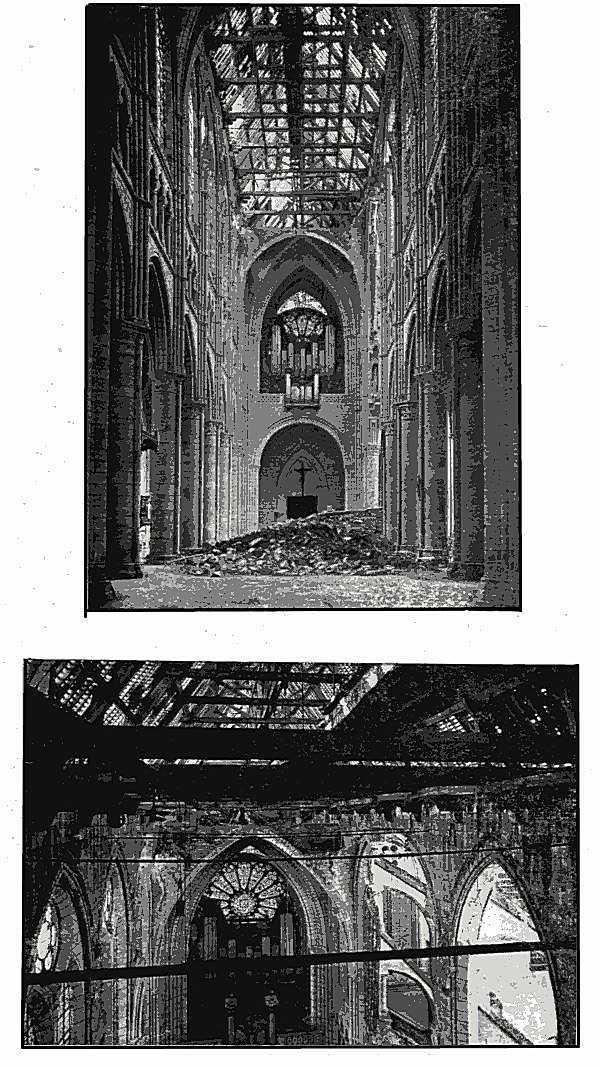
THE FALLEN VAULTING LEFT BARE THE DAMAGED FRAMEWORK OF THE ROOF.
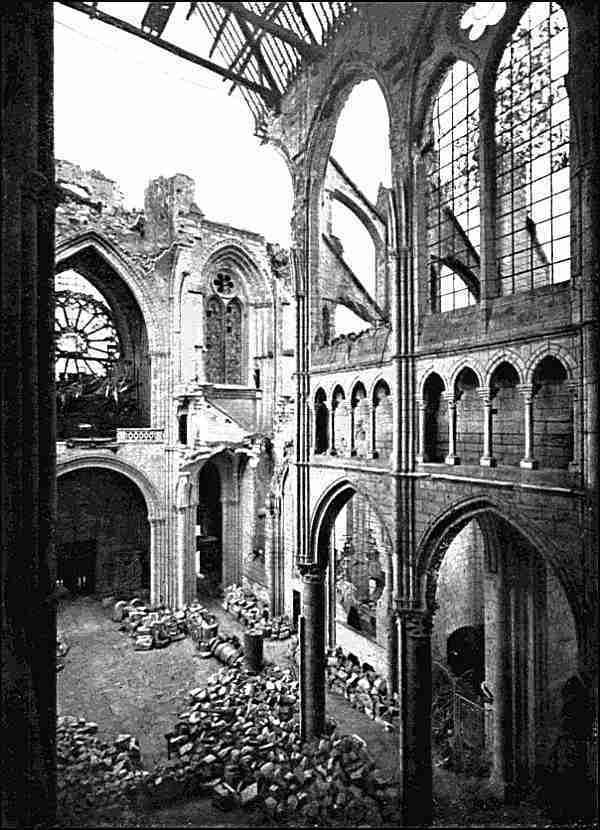
BREACH IN THE NAVE, NOVEMBER 1918.
The fall of the Vaulting.
The vaults of the remaining bays, already weakened, could not withstand the renewed bombardments. One after another they crashed to the ground, with the exception of those of the first and seventh bays. Everywhere else, pieces of broken or disjointed framework, supporting a completely ruined roof, are exposed to view (photoabove).
Several of the large windows on the north side have also fallen in and all the stained-glass has been smashed.
The
Final Ruin.
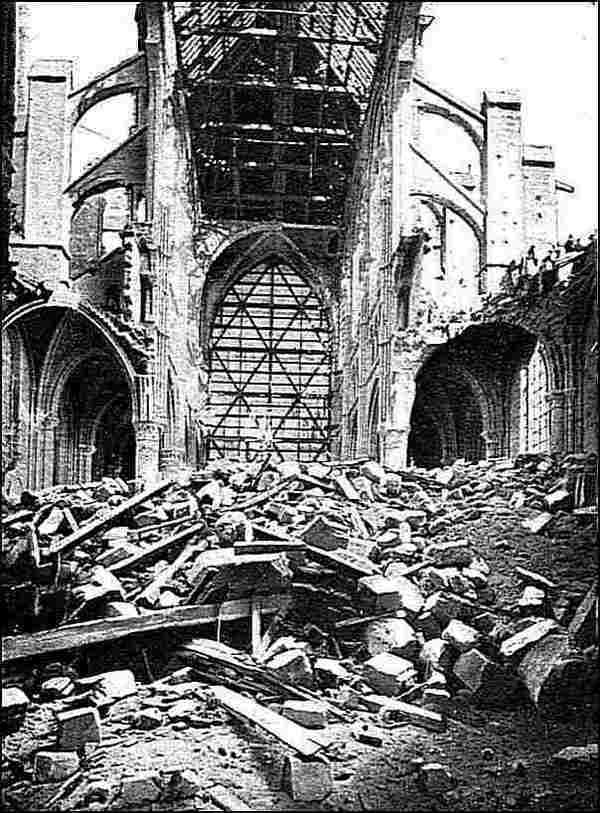
THE NAVE, AUGUST 1918.
The bombardments of 1918 destroyed the nave beyond hope of repair.
Several large pillars collapsed and a considerable portion of the upper part of the side walls, large arches and triforium fell in to the right and left.
Three bays near the west front, with their large arches and the aisles were completely destroyed. All this masonry fell inside the nave, forming across its entire breadth a heap of debris more than 19 feet high and about 33 feet long.
Fragments of vaulting, bases of pillars, stones from the roof, were mixed in shapeless chaos with a quantity of architectural and sculptured motives, notably the beautiful capitals and the key-stones of the vault, mostly broken. And on this heap of ruins the rooftimbers of the framework, deprived of all support, fell by degrees in their turn.
The old harmonious construction of the nave is now to be seen only in the bays nearest the transept.
The Chapelle des Œuvres was struck several times. The most serious damage was caused during the first bombardments of 1914 by a shell which exploded on the roof of the gallery (B on plan p. 18, photobelow) which leads to the chapel. Penetrating the roof and the framework, it caused the vault to fall in, broke the arches, and shattered the stained-glass of the chapel windows.
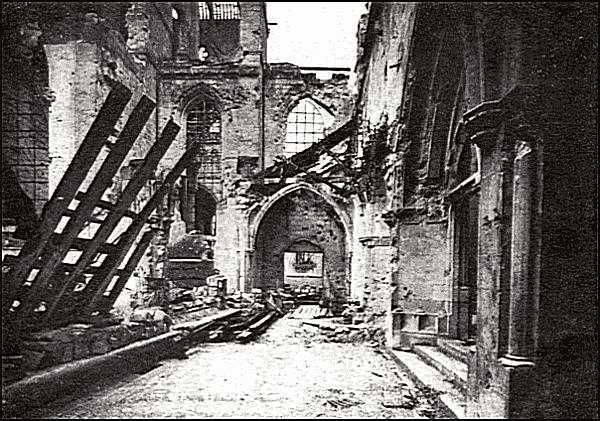
GALLERY GIVING ACCESS TO THE CHAPELLE DES ŒUVRES, NOV. 1918.
